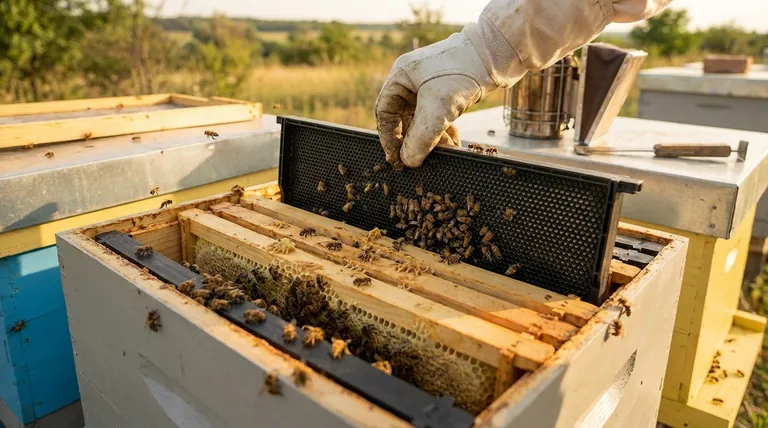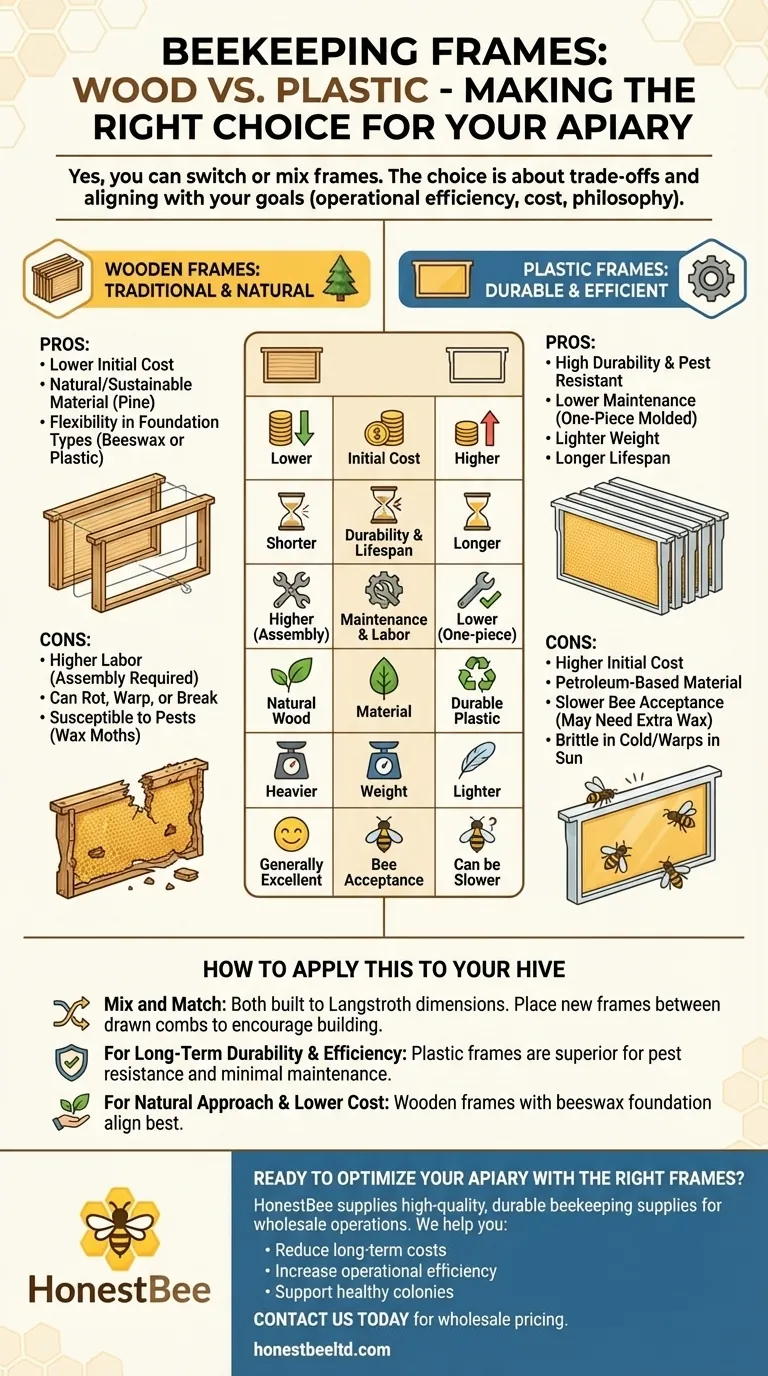Yes, you can. Beekeepers are not locked into their initial choice and can freely switch between wooden and plastic frames. You can even use a mix of both types within the same hive to determine which works better for your specific needs and your bees' preferences.
The choice between wood and plastic is not about finding a single "best" frame, but about understanding a set of trade-offs. Your decision should align with your primary goals, whether they are operational efficiency, cost, or a specific beekeeping philosophy.

The Fundamental Differences: Wood vs. Plastic
While both frame types serve the same function, their material properties create distinct advantages and disadvantages that influence your day-to-day beekeeping and long-term strategy.
The Case for Wooden Frames
Wooden frames are the traditional standard in beekeeping. They are typically made from pine and appeal to those who prefer using natural, sustainable materials in their hives.
Their primary advantage is often a lower initial purchase price compared to plastic. They also offer the flexibility of using different foundation types, such as natural beeswax or plastic foundation sheets.
The Case for Plastic Frames
Plastic frames are valued for their durability and efficiency. They are often sold as a single, molded piece with the foundation pattern built-in, eliminating the need for assembly.
These frames are resistant to pests like wax moths and will not rot or warp, giving them a significantly longer lifespan than wood. They are also lighter, which makes lifting heavy boxes of honey more manageable.
Understanding the Trade-offs
Neither option is perfect. Your choice requires weighing the benefits of one against the drawbacks of the other.
The Downsides of Wood
Wooden frames require more initial labor. They must be assembled and often wired before a wax or plastic foundation can be installed.
Over time, wood can degrade. It is susceptible to damage from hive tools, can be chewed by pests, and may break down after several seasons of use, requiring replacement.
The Downsides of Plastic
Some beekeepers observe that bees can be slower to draw out comb on new, smooth plastic frames. This can sometimes be mitigated by applying an extra layer of beeswax.
While durable, plastic is a petroleum product, which is a concern for environmentally-conscious beekeepers. They can also become brittle in very cold climates or warp if left in direct sun outside the hive.
How to Apply This to Your Hive
You can effectively mix frames without issue, as both types are built to standard Langstroth dimensions. Placing a new frame, regardless of type, between two fully drawn combs can encourage the bees to build it out more quickly.
- If your primary focus is long-term durability and efficiency: Plastic frames are the superior choice due to their pest resistance and minimal maintenance.
- If your primary focus is a natural approach and lower initial cost: Wooden frames with beeswax foundation align best with this philosophy.
- If you are unsure or want to optimize for your bees: Start with a mix of both to see which type your colony draws out faster and which you prefer handling during inspections.
Ultimately, the best frame is the one that supports a healthy colony and makes your beekeeping practice more successful and enjoyable.
Summary Table:
| Feature | Wooden Frames | Plastic Frames |
|---|---|---|
| Initial Cost | Lower | Higher |
| Durability & Lifespan | Shorter; can rot or warp | Longer; pest and rot resistant |
| Maintenance & Labor | Higher (requires assembly) | Lower (often one-piece) |
| Material | Natural, sustainable wood | Durable, petroleum-based plastic |
| Weight | Heavier | Lighter |
| Bee Acceptance | Generally excellent | Can be slower; may need extra wax coating |
Ready to Optimize Your Apiary with the Right Frames?
Whether you're a commercial apiary focused on long-term efficiency or a distributor stocking up on reliable equipment, the right frames are critical to your success. HONESTBEE supplies high-quality, durable beekeeping supplies and equipment through wholesale-focused operations.
We help you:
- Reduce long-term costs with durable, low-maintenance equipment.
- Increase operational efficiency with standardized, reliable products.
- Support healthy colonies with equipment designed for optimal bee health.
Contact us today to discuss your needs and get a quote on our wholesale supplies. Let's build a more productive and profitable beekeeping operation together.
Get in Touch for Wholesale Pricing →
Visual Guide

Related Products
- Plastic Bee Frame Beekeeping Hive Frames for Wholesale
- Assembled Wooden Bee Frames with Plastic Foundation for Durability and Convenience by HONESTBEE
- Plastic Honey Comb Frames Cassette Box for Honey
- Assembled Wooden Bee Frames with Beeswax Foundation Ready to Use by HONESTBEE
- 7 x Auto Bee Flow Hive Frames Plastic Beekeeping Hive Box Supplies
People Also Ask
- What are the differences between wooden and plastic frames in beehives? Choose the Best for Your Apiary
- What are the advantages of plastic frames for beehives? Boost Apiary Efficiency & Durability
- Why are plastic frames popular in commercial beekeeping? Boost Efficiency & Durability at Scale
- What is the role of oxalic acid in plants? A Key to Plant Defense and Internal Regulation
- What are the main types of frames available for beehives? Wood vs. Plastic for Your Apiary



















